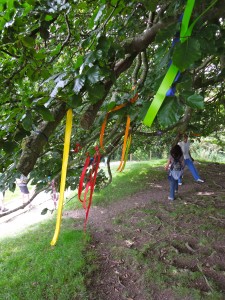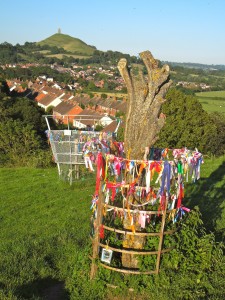Shinboku
Go to visit a Shinto shrine and you’ll surely find a shinboku – a sacred tree favoured by the kami. But what makes some trees sacred and others not? It’s a question I’ve often asked priests about, and the answer varies from place to place. Mostly it’s simply a case of tradition: the trees were identified in ancient times and the original reason has long been forgotten.
Sometimes however there is an obvious singularity about the tree. It may be unusually large or flourishing, expressive of natural vitality. It may occupy a special position, marked by an unusual event or adjacent to a shrine. It may have been struck by lightning, signifying descent of the kami. And, in keeping with the Siberian shamanic tradition, it may have a distinctive shape such as a split trunk or phallic and vulvic features.
Shinto is sometimes described as a nature religion though it’s far more than that, and the idea of tree spirits certainly play an important part. The Association of Shrines has been lamentably slow in picking up the environmental cause, showing a greater concern with nationalistic and emperor-centred issues, yet there are signs in its promotion of ‘sacred groves’ that it is awakening to the implications of a ‘sacred tree’ philosophy (see here).

Pagan prayer ribbons at a beech grove by Avebury stone circle
Tree spirits
By contrast with Shinto, the burgeoning neo-pagan movement has been driven by ecological concerns from at least the 1970s, when I was a member of PAN (Pagans against Nukes). The idea that trees are more than simply beautiful or useful led to the stereotype of ‘tree-hugging hippies’, keen to commune with the spirit of nature. But where does such a notion have its ‘roots’?
Tree worship is such a huge subject that perhaps the best thing is to quote from Wikipedia to show how deep it is rooted in the human consciousness:
“Human beings, observing the growth and death of trees, the elasticity of their branches, the sensitivity and the annual decay and revival of their foliage, see them as powerful symbols of growth, decay and resurrection. The most ancient cross-cultural symbolic representation of the universe’s construction is the world tree.
The image of the Tree of life is also a favourite in many mythologies. Various forms of trees of life also appear in folklore, culture and fiction, often relating to immortality or fertility. These often hold cultural and religious significance to the peoples for whom they appear. For them, it may also strongly be connected with the motif of the world tree.
Other examples of trees featured in mythology are the Banyan and the Peepal (Ficus religiosa) trees in Hinduism, and the modern tradition of the Christmas Tree in Germanic mythology, the Tree of Knowledge of Judaism and Christianity, and the Bodhi tree in Buddhism. In folk religion and folklore, trees are often said to be the homes of tree spirits. Historical Druidism as well as Germanic paganism appear to have involved cultic practice in sacred groves, especially the oak. (The term druid itself possibly derives from the Celtic word for oak.) “
Wisdom
In Celtic folklore trees were the physical representation of the wisdom of the earth, as if drawing on the deep unconsciousness of the world below to rise up towards the light. (No doubt a similar notion underlies the biblical Tree of Knowledge.) In restoring reverence for the spirit of the tree, neo-paganism is thus reclaiming a connection to nature.
Like sacred trees, humans are born out of mother earth and are dependent on its whims and providence. It’s a concept that informed ancient kami worship, but one that is often lost in the shrunken groves of modern shrines with their formulaic rituals and concrete carparks.
Perhaps it’s high time to restore the sacred tree to a place of centrality. Not just once a year with a sacrilegiously chopped down Christmas tree, but everyday and in every way. The woods were mankind’s earliest temples, and from them derive the World Tree, the Bodhi Tree, the Tree of Knowledge and the very Tree of Life. Blessings and gratitude indeed.
********************************************************************************************************



Leave a Reply